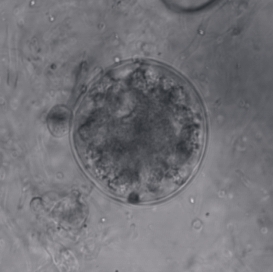Roseolovirus is a genus of viruses in the order Herpesvirales, in the family Herpesviridae, in the subfamily Betaherpesvirinae. There are currently six species in this genus. Diseases associated with this genus include: HHV-6: sixth disease ; HHV-7: symptoms analog to the 'sixth disease'.

Eurotiomycetes is a large class of ascomycetes with cleistothecial ascocarps within the subphylum Pezizomycotina, currently containing around 3810 species according to the Catalogue of Life. It is the third largest lichenized class, with more than 1200 lichen species that are mostly bitunicate in the formation of asci. It contains most of the fungi previously known morphologically as "Plectomycetes".

Spizellomycetales is an order of fungi in the Chytridiomycetes. Spizellomycetalean chytrids are essentially ubiquitous zoospore-producing fungi found in soils where they decompose pollen. Recently they have also been found in dung and harsh alpine environments, greatly expanding the range of habitats where one can expect to find these fungi.

Pleosporaceae is a family of sac fungi. They are pathogenic to humans or saprobic on woody and dead herbaceous stems or leaves.

Diaporthales is an order of sac fungi.

Lymphocryptovirus is a genus of viruses in the order Herpesvirales, in the family Herpesviridae, in the subfamily Gammaherpesvirinae. This genus includes the human-infecting Human gammaherpesvirus 4, as well as viruses that infect both Old World monkeys and New World monkeys. Other names for the Lymphocryptovirus genus include Lymphocryptoviridae and gamma-1 herpesviruses. There are nine species in this genus. Diseases associated with this genus include: mononucleosis, Burkitt's lymphoma, and nasopharyngeal carcinoma.
Howard Elson Bigelow was an American mycologist, born in 1923 in Greenfield, Massachusetts, and died in 1987. He studied at Oberlin College from 1941 to 1943. He left college to fight in the American army. He returned to Oberlin after the war and obtained his Bachelor of Arts in 1949 and his Master of Arts in 1951. He studied botany at the University of Michigan under the guidance of Alexander Hanchett Smith (1904–1986) and received his doctorate in 1956. He was wed to mycologist Margaret Elizabeth Barr-Bigelow in 1956. Bigelow and his wife worked for University of Massachusetts from 1957 to his death. He is the author of works on the fungi of the genus Clitocybe and the family Tricholomataceae.

Lepteutypa is a genus of plant pathogens in the family Amphisphaeriaceae. First described by the Austrian mycologist Franz Petrak in 1923, the genus contains 10 species according to a 2008 estimate. It was increased to 15 in 2020.
Chapeckia is a genus of fungi in the family Sydowiellaceae. The genus was described by mycologist Margaret Elizabeth Barr-Bigelow in 1978.
Mexisphodrus is a genus of ground beetles in the family Carabidae. There are about 12 described species in Mexisphodrus, found in North America.

Rhadine is a genus of beetles in the family Carabidae, containing the following species:
The Endochytriaceae are a family of fungi in the order Cladochytriales. The family contains 10 genera and 56 species according to a 2008 estimate. It was circumscribed by mycologist Donald J.S. Barr in 1980.

Enoclerus is a genus of checkered beetles in the subfamily Clerinae.
Bryelmis is a genus of riffle beetles in the family Elmidae. There are at least three described species in Bryelmis.
Araeodontia is a genus of checkered beetles in the family Cleridae. There are about five described species in Araeodontia.
Gorilline gammaherpesvirus 1 (GoHV-1), commonly known as herpesvirus gorilla is a species of virus in the genus Lymphocryptovirus, subfamily Gammaherpesvirinae, family Herpesviridae, and order Herpesvirales.
Macacine gammaherpesvirus 4 (McHV-4), commonly known as rhesus lymphocryptovirus (RLV), is a species of virus in the genus Lymphocryptovirus, subfamily Gammaherpesvirinae, family Herpesviridae, and order Herpesvirales.
Panine gammaherpesvirus 1 (PnHV-1), commonly known as chimpanzee lymphocryptovirus, is a species of virus in the genus Lymphocryptovirus, subfamily Gammaherpesvirinae, family Herpesviridae, and order Herpesvirales.
Pongine gammaherpesvirus 2 (PoHV-2), commonly known as orangutan herpesvirus, is a species of virus in the genus Lymphocryptovirus, subfamily Gammaherpesvirinae, family Herpesviridae, and order Herpesvirales.
Gaertneriomyces is a genus of fungi belonging to the family Spizellomycetaceae.







